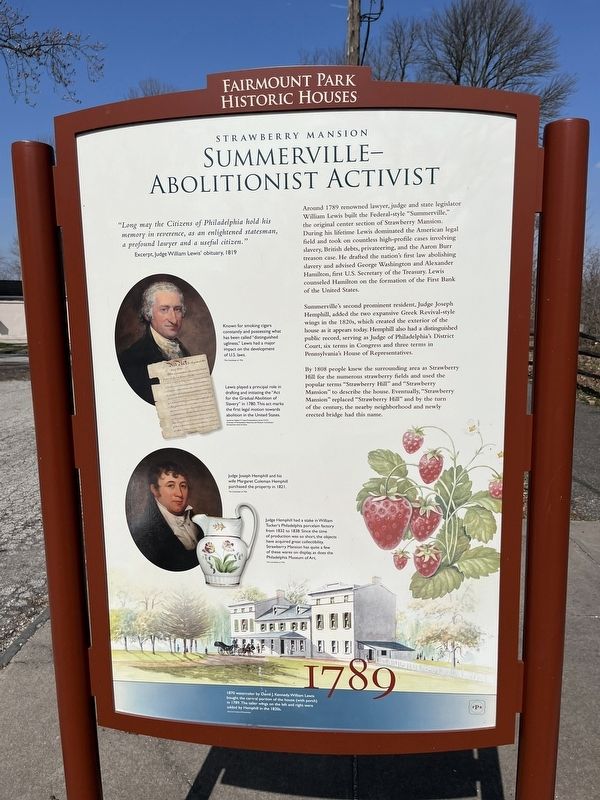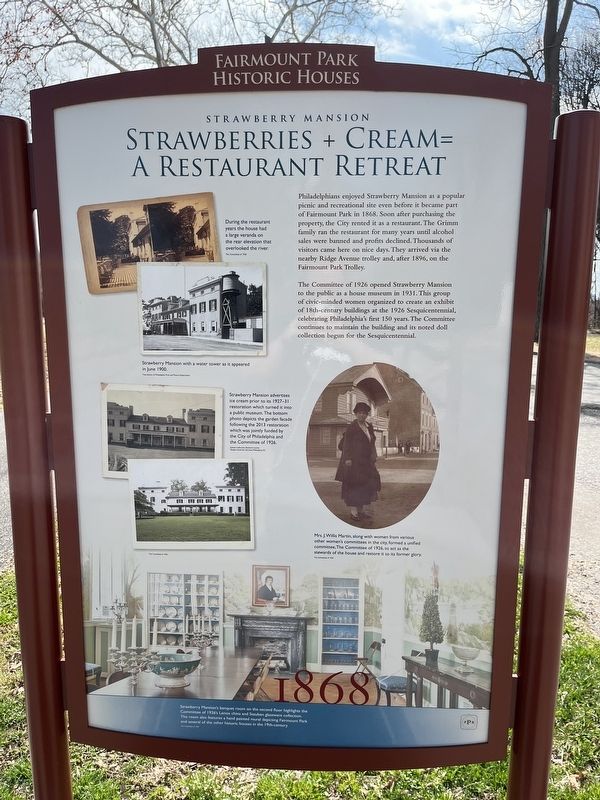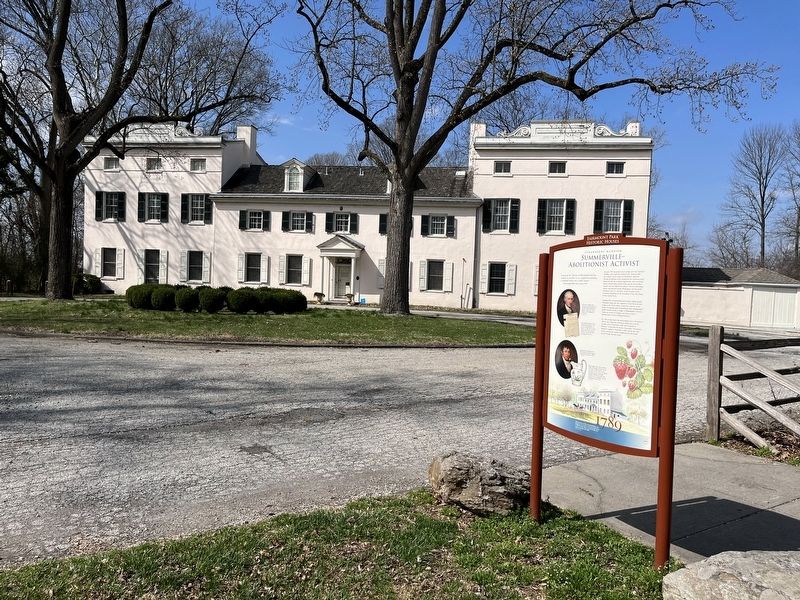Fairmount Park in Philadelphia in Philadelphia County, Pennsylvania — The American Northeast (Mid-Atlantic)
Summerville-Abolitionist Activist / Strawberries + Cream = A Restaurant Retreat
Strawberry Mansion
— Fairmount Park Historic Houses —

Photographed By Devry Becker Jones (CC0), March 19, 2022
1. Summerville—Abolitionist Activist side of the marker
Summerville—Abolitionist Activist
1789
"Long may the Citizens of Philadelphia hold his memory in reverence, as an enlightened statesman, a profound lawyer and a useful citizen."
Excerpt, Judge William Lewis' obituary, 1819
Around 1789 renowned lawyer, judge and state legislator William Lewis built the Federal-style "Summerville," the original center section of Strawberry Mansion. During his lifetime Lewis dominated the American legal field and took on countless high-profile cases involving slavery, British debts, privateering, and the Aaron Burr treason case. He drafted the nation's first law abolishing slavery and advised George Washington after Alexander Hamilton, first U.S. Secretary of the Treasury. Lewis counseled Hamilton on the formation of the First Bank of the United States.
Summerville's second prominent resident, Judge Joseph Hemphill, added the two expansive Greek Revival-style wings in the 1820s, which created the exterior of the house as it appears today. Hemphill also had a distinguished public record, serving as Judge of Philadelphia's District Court, six terms in Congress and three terms in Pennsylvania's House of Representatives.
By 1808 people knew the surrounding area as Strawberry Hill for the numerous strawberry fields and used the popular terms "Strawberry Hill" and "Strawberry Mansion" to describe the house. Eventually, "Strawberry Mansion" replaced "Strawberry Hill" and by the turn of the century, the nearby neighborhood and newly erected bridge had this name.
[Captions:]
Known for smoking cigars constantly and possessing what has been called "distinguished ugliness," Lewis had a major impact on the development of U.S. laws.
Lewis played a principal role in drafting and initiating the "Act for the Gradual Abolition of Slavery" in 1780. This act marks the first legal motion towards abolition in the United States.
Judge Joseph Hemphill and his wife Margaret Coleman Hemphill purchased the property in 1821.
Judge Hemphill had a stake in William Tucker's Philadelphia porcelain factory from 1832 to 1838. Since the time of production was so short, the objects have acquired great collectibility. Strawberry Mansion has quite a few of these wares on display, as does the Philadelphia Museum of Art.
1870 watercolor by David J. Kennedy. William Lewis bought the central portion of the house (with porch) in 1789. The taller wings on the left and right were added by Hemphill in the 1820s.
Strawberries + Cream = A Restaurant Retreat
1868
Philadelphians enjoyed Strawberry

Photographed By Devry Becker Jones (CC0), March 19, 2022
2. Strawberries + Cream = A Restaurant Retreat side of the marker
The Committee of 1926 opened Strawberry Mansion to the public as a house museum in 1931. This group of civic-minded women organized to create an exhibit of 18th-century buildings at the 1926 Sesquicentennial, celebrating Philadelphia's first 150 years. The Committee continues to maintain the building and its noted doll collection begun for the Sesquicentennial.
[Captions:]
During the restaurant years the house had a large veranda on the rear elevation that overlooked the river.
Strawberry Mansion with a water tower as it appeared in June 1900.
Strawberry Mansion advertises ice cream prior to its 1927-31 restoration which turned it into a public museum. The bottom photo depicts the garden facade following the 2013 restoration which was jointly funded by the City of Philadelphia and the Committee of 1926.
Mrs. J. Willis Martin, along with the women from various other women's committees in the
Strawberry Mansion's banquet room on the second floor highlights the Committee of 1926's Lenox china and Steuben glassware collection. The room also features a hand painted mural depicting Fairmount Park and several of the other historic houses in the 19th-century.
Erected by Fairmount Park Conservancy.
Topics. This historical marker is listed in these topic lists: Abolition & Underground RR • Architecture • Government & Politics • Industry & Commerce. A significant historical month for this entry is June 1900.
Location. 39° 59.661′ N, 75° 11.409′ W. Marker is in Philadelphia, Pennsylvania, in Philadelphia County. It is in Fairmount Park. Marker is on Greenland Drive, 0.1 miles east of Strawberry Mansion Bridge Drive, on the right when traveling north. Touch for map. Marker is at or near this postal address: 2450 Strawberry Mansion Dr, Philadelphia PA 19132, United States of America. Touch for directions.
Other nearby markers. At least 8 other markers are within walking distance of this marker. Strawberry Mansion (within shouting distance of this marker); Apricot (within shouting distance of this marker); a different marker also named Apricot (within shouting distance of this marker); Asian Persimmon (within shouting distance of this marker); Apple (within shouting distance of this marker); a different marker also named Apple (within shouting distance of this marker); William Lewis (within shouting distance of this marker); Strawberry Mansion Bridge (about 600 feet away, measured in a direct line). Touch for a list and map of all markers in Philadelphia.
Credits. This page was last revised on February 2, 2023. It was originally submitted on March 21, 2022, by Devry Becker Jones of Washington, District of Columbia. This page has been viewed 120 times since then and 13 times this year. Photos: 1, 2, 3. submitted on March 21, 2022, by Devry Becker Jones of Washington, District of Columbia.
